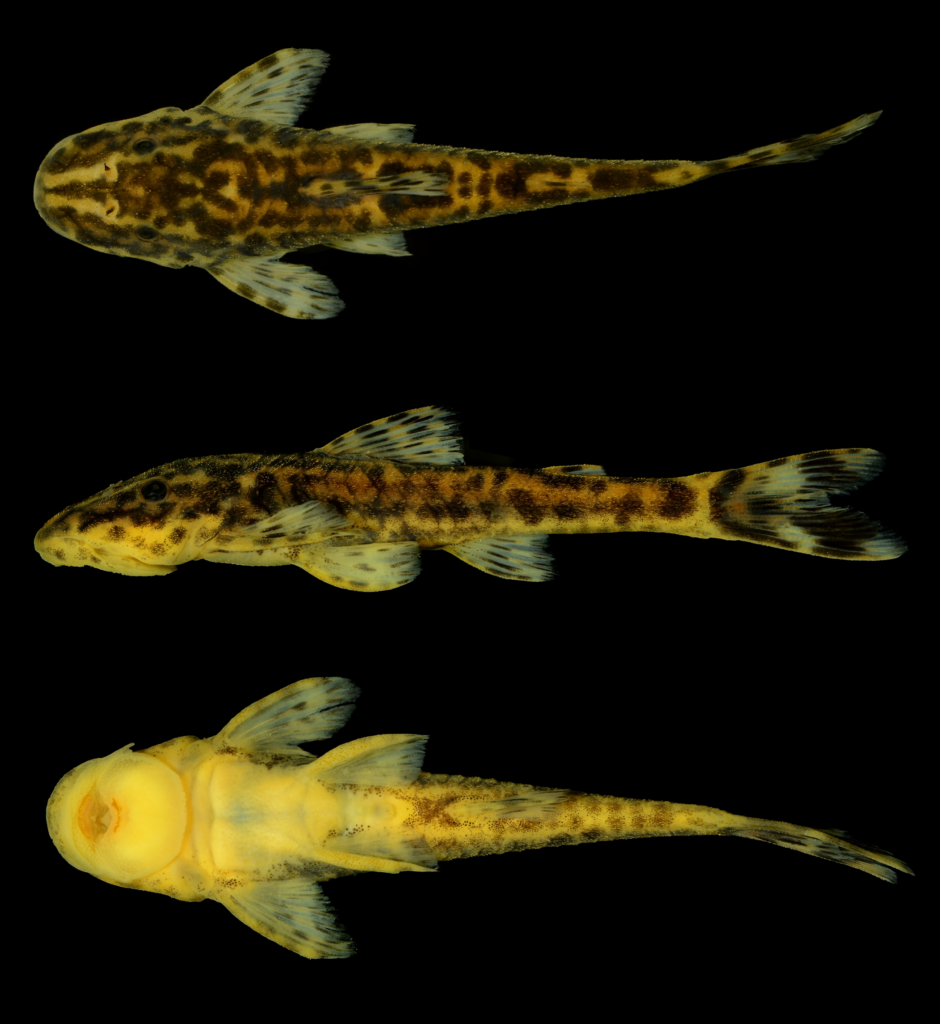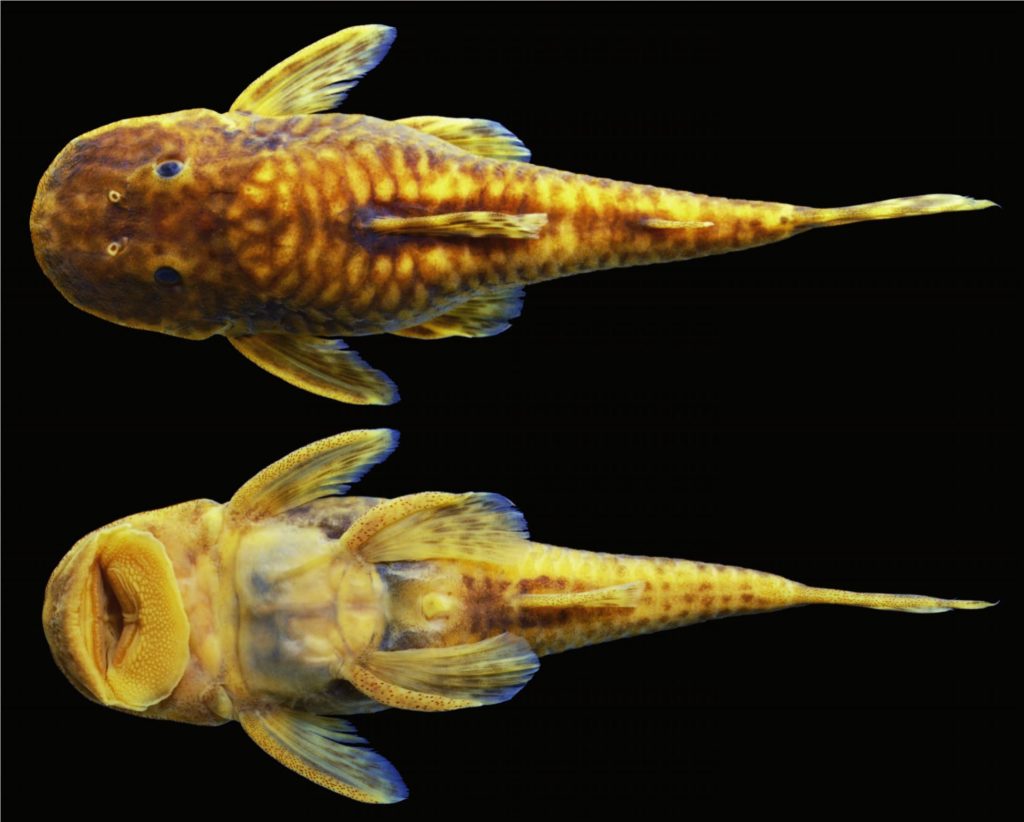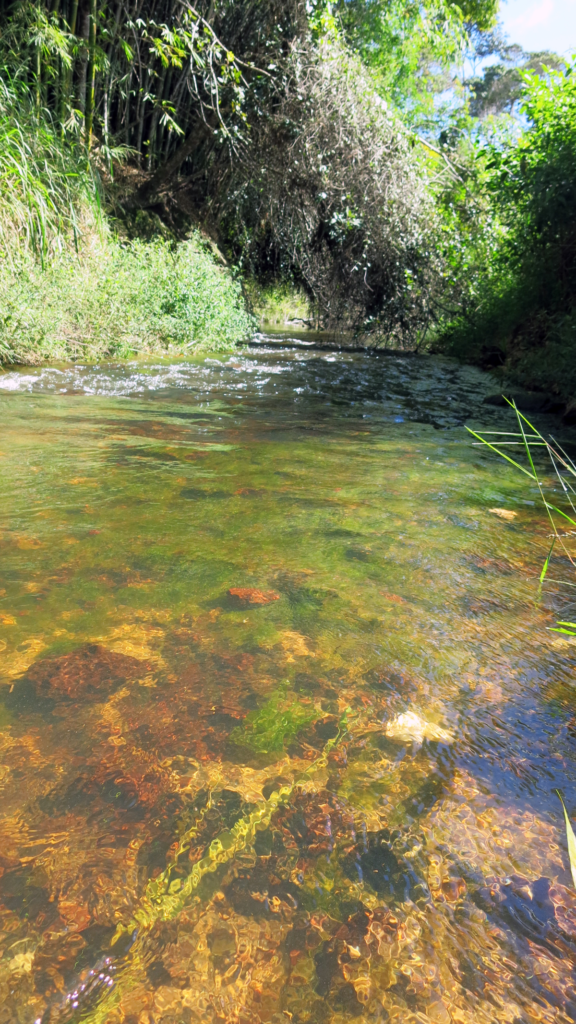
Parotocinclus nandae, holotype. This 39.8 mm SL, male was from the upper Rio Paraguaçu, Ibicoara, Bahia, Brazil. Image published in Lehmann A., Camelier, and Zanata 2020.
A new marbled loricariid catfish has been described from the upper Paraguaça basin in Brazil. Authors Pablo Lehmann A., Priscila Camelier, and Angela Zanata published their findings in the open-access journal PLoS One. The new taxon, Parotocinclus nandae, is the seventh species of loricariid known from the Río Paraguaça basin, and it is also considered to be an endemic of the area. The epithet honors the daughter of the first author of the paper who is affectionately called “Nanda”.
Descriptive Features
The unique coloration of Parotocinclus nandae is described as a marble-spotted pattern created by irregular dark blotches on a light yellow background. The yellow transitions from a light yellow to more of a golden yellow towards the dorsal portion of the fish. On the top of the head, there are two light lines that extend from the tip of the snout to the nares forming a V-shaped mark. Its lips are well-developed (longer than wide) on the ventral surface of the head with fringed edges densely covered by papillae. Lip borders and barbel tips are translucent.

Color in life of Parotocinclus nandae paratype, 40.7 mm SL, Brazil, Bahia, Ibicoara, upper Rio Paraguaçu basin. Image published in Lehmann A., Camelier, and Zanata 2020.
These fish are medium to large members of Parotocinclus. The maximum documented length was that of a 46.2 mm SL female. Females averaged slightly larger than males in the specimens examined (39.6 mm and 37.6 mm SL respectively).
In addition to differences in size, P. nandae also exhibit other sexually dimorphic features. Male fish have a conical urogenital papilla and longer pelvic fins than females. Uniquely, the dorsal interradial membranes of the pelvic fins of females are covered by thick, opaque skin. This is the first encountered species in Siluriformes to possess this trait, which is speculated to be related to pheromone production. Further studies however will need to be conducted to verify this notion.

Female P. nandae exhibit thick skin covering the dorsal surface of the pelvic-fin at interradial membranes. Image from Lehmann A., Camelier, and Zanata 2020.
Distribution and Habitat
Parotocinclus nandae is known from two localities in the Río Paraguaça basin in the state of Bahia in eastern Brazil.
At this locality, the upper Río Paraguaça is a small clear water stream with both swift currents and slow-moving backwaters. Parotocinclus nandae were caught in stretches of fast current, 2-4 meters wide and less than 1 meter deep. The stream bottom was composed of pebbles, organic debris, and subaquatic vegetation. Astyanax hamatilis and Rhamdia sp. were also present.
The second recorded location was in the Río Capivari, a tributary of the Río São José also in the Río Paraguaçu basin. No environmental data were provided, but the syntopic presence of Parotacinclus adamanteus, a species described in 2019, was noted.

Parotocinclus adamanteus, a co-occurring species in the Río Capivari. Image from Pereira et al., 2019.
Reference to Species Description:
Article Abstract:
A new species of Parotocinclus from the upper Río Paraguaçu, Bahia, Brazil, is described. The new species is distinguished from all congeners by its unique color pattern, with irregular dark blotches resulting in a somewhat marble-spotted pattern on head and trunk of most specimens and dorsum of head with a conspicuous V-shaped light mark from tip of snout to nares. The new species is also distinguished from congeners by having the lower lip elongated posteriorly and reaching or surpassing the anterior margin of cleithrum on the pectoral girdle, the canal cheek plate on the ventral surface of the head reduced and with a slightly concave margin, and an abdomen covered by small embedded platelets, without contact with each other and not arranged in a line between the pectoral-fin axilla and the pelvic-fin origin. The presence of a thick and rough skin in the interradial membrane of the pelvic fin exclusively in the females of P. nandaeis reported for the first time to occur in Siluriformes.
Additional Reference:
Pereira, E.H.L., A.C. de A. Santos, M.C.C. de Pinna, and R.E. Reis. 2019. An enigmatic new loricariid (Actinopterygii: Siluriformes) from relictual upper reaches of Chapada Diamantina, Bahia, Brazil. Copeia 107 (4): 597-605.




